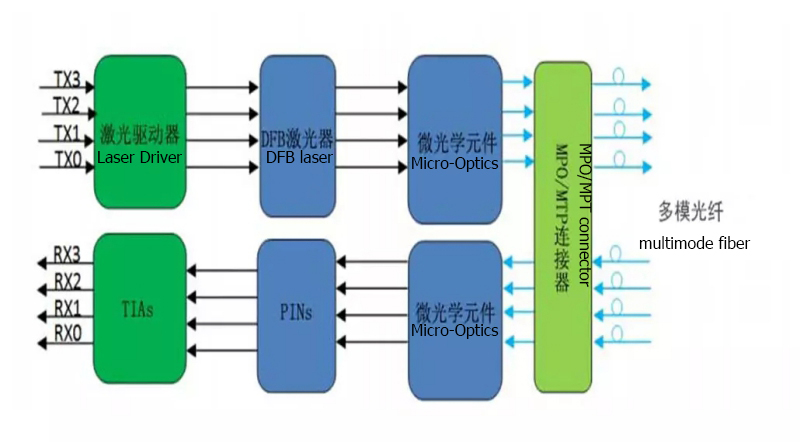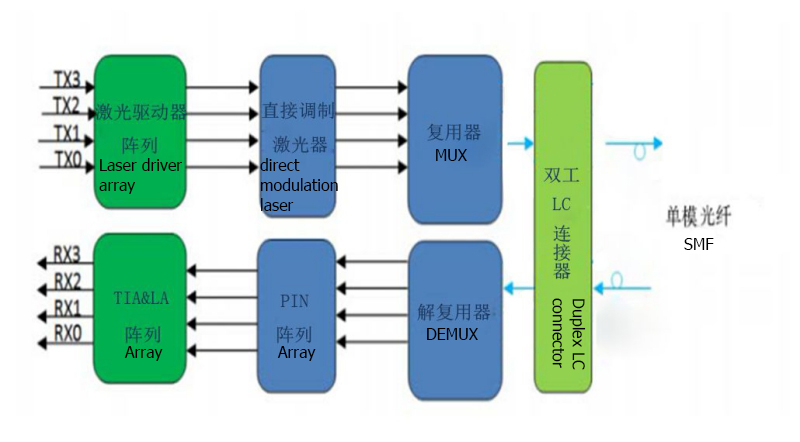100G has a variety of packaging forms, including CFP/CFP2/CFP4, CXP, and QSFP28. Among these different 100G packaging forms, the QSFP28 optical module has become the main packaging method for 100G networks because of its high port density, low power consumption, and low cost. Therefore, today we will focus on four types of 100G QSFP28 optical modules.
QSFP28 SR4 optical module is a parallel 100G optical module, which has the advantages of high port density and low cost. It follows the IEEE802.3ba standard and was officially released in 2015. It uses 8-core multimode fiber for parallel transmission. The module interface uses 12-core MPO (the middle 4-core is not enabled), and each channel supports 25G, which is consistent with the 40Gbase-SR4 interface. Conventional OM3 and OM4 multimode fibers can transmit distances of 70m and 100m.
When the QSFP SR4 optical module transmits signals at the transmitting end, the electrical signals are converted into optical signals by the laser array, and then transmitted in parallel on the multimode fiber. When reaching the receiving end, the photodetector array converts the parallel optical signals into parallel Electrical signal, the following is the working principle diagram of QSFP28 SR4 optical module:

QSFP28-LR4 optical modules are usually used with single-mode optical fibers. The working wavelength is 1310nm and the maximum transmission distance can reach 10km. It provides an ideal solution for the increasing transmission distance requirements of ultra-large data centers.
QSFP28 LR4 optical module is generally used with LC single-mode optical fiber cable. It converts 4 channels of 25Gbps electrical signals into 4 channels of LAN WDM optical signals and then multiplexes them into a single channel to realize 100G optical transmission. At the receiving end, the module demultiplexes 100G optical input into 4 LAN WDM optical signals and then converts them into 4 electrical signal output channels. The following is the working principle diagram of the QSFP28 LR4 optical module:

The QSFP28-PSM4 optical module is a high-speed, low-power product that complies with the PSM4 MSA standard, has a hot-swappable QSFP form factor, and has a built-in digital diagnostic function.
Using single-mode fiber parallel transmission mode, each 100G model uses 8-core single-mode fiber to form a total of 4 independent channels, and each channel transmits data up to 26Gbps optical modules. The fiber transmission model is similar to 100G-SR4, with the biggest difference PSM4 uses single-mode fiber as the transmission medium.
The QSFP28-CWDM4 optical module follows the CWDM4 MSA standard, adopts a duplex LC interface, and uses four central wavelengths of 1271nm, 1291nm, 1311nm, and 1331nm for optical signal transmission, and each band transmits 25G. Through the coarse wavelength division multiplexing technology, the above 4 wavelengths are used for transmission on single-mode fiber.
In order to ensure the stability of the optical fiber transmission system, the 100G-CWDM4-QSFP28 optical module must be used in an optical fiber link with forwarding error correction.
This module adopts the QSFP28 package, it is a kind of hot-swappable optical module, and the transmission distance can reach 2km when used with single-mode fiber. Compared with the traditional LR4 solution, the wavelength interval is increased, and uncooled DML is used as the light source, which has certain price advantages in 2km transmission applications.
The above information is provided by the transceiver supplier.
Previous: Oyster Bag
Next: Frozen Red Pepper cubes
Copyright:@2020-2021
Comments Please sign in or sign up to post.
0
0 of 500 characters used